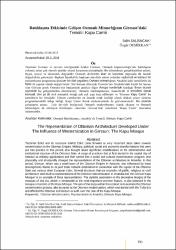| dc.contributor.author | Salbacak, Salih | |
| dc.contributor.author | Demirkan, Özgür | |
| dc.date.accessioned | 2021-05-28T13:08:47Z | |
| dc.date.available | 2021-05-28T13:08:47Z | |
| dc.date.issued | 2018 | en_US |
| dc.identifier.citation | SALBACAK, Salih & Özgür DEMİRKAN. "Batılılaşma Etkisinde Gelişen Osmanlı Mimarlığının Giresun’daki Temsili: Kapu Camii". Karadeniz Sosyal Bilimler Dergisi, 10.19 (2018): 593-603. | en_US |
| dc.identifier.uri | https://dergipark.org.tr/tr/pub/ksbd/issue/41531/501292 | |
| dc.identifier.uri | https://hdl.handle.net/11352/3573 | |
| dc.description.abstract | Tanzimat Fermanı ve devamı niteliğindeki Islahat Fermanı, Osmanlı İmparatorluğu’nda batılılaşma yolunda atılan çok önemli adımlar olarak karşımıza çıkmaktadır. Bu dönemlerde gerçekleştirilen askeri, siyasi, sosyal ve ekonomik değişimler Osmanlı devletinin idari ve kurumsal yapısında da önemli değişiklikler getirmiştir. Başkent İstanbul’da başlayan öncelikle askeri ardından toplumsal ve kültürel bir modernleşme programına dönüşen bir dizi uygulama Osmanlı mimarlığının Anadolu’daki temsillerini de fiziki ve yapısal olarak değiştirmiştir. Söz konusu dönemde Osmanlı’nın Anadolu’daki küçük bir kazası olan Giresun gerek Osmanlı’nın başkentiyle gerekse diğer Avrupa kentleriyle kurduğu liman ticareti sayesinde bu gelişmelerden etkilenmiştir. Osmanlı batılılaşmasının Anadolu’da ki temsilleri olarak kamusal, dini ya da sivil mimarlık örneği pek çok yapı inşa edilmiştir ve ‘Giresun Kapu Camii’ bu temsillerin bir örneğidir. Dönem camilerinin en önemli ortak özelliği olarak dikkati çeken süsleme programlarındaki üslup birliği, Kapu Camii barok süslemelerinde de gözlenmektedir. Bu eksende çalışmanın amacı; Lale devriyle başlayarak Osmanlı modernleşmesi olarak okunan ve Osmanlı Mimarlığını da etkileyen batılılaşma sürecinin Giresun’daki temsilinin ‘Kapu Camii’ üzerinden okunmasıdır. | en_US |
| dc.description.abstract | Tanzimat Edict and its successor Islahat Edict come forward as very important steps taken towards westernization in the Ottoman Empire. Military, political, social and economic transformations that were put into practice in this period, also brought about significant modifications in the administrative and institutional structure of the Ottoman State. A range of practices that at first started in the capital city of Istanbul as military applications and then turned into a social and cultural modernization program, also physically and structurally changed the representations of the Ottoman architecture in Anatolia. In that period, Giresun, which was a small town of the Ottoman Empire in Anatolia, was influenced by these developments thanks to its port trade network established in connection with the capital of the Ottoman State and various other European cities. Several structures that are examples of public, religious or civil architecture were built as representations of the Ottoman Westernization in Anatolia and 'the Giresun Kapu Mosque' is an example of these representations. The stylistic association in the decorative designs of the mosques of that era, which is remarkable as the most important common feature, is also observed in the baroque ornaments of the Kapu Mosque. The aim of the study within this context; is to examine the Ottoman westernization process, also accepted as the Ottoman modernization, which was started with the Tulip Era and affected the Ottoman architecture as well, over the case of the Kapu Mosque. | en_US |
| dc.language.iso | tur | en_US |
| dc.publisher | Giresun Üniversitesi | en_US |
| dc.rights | info:eu-repo/semantics/openAccess | en_US |
| dc.subject | Osmanlı Batılılaşması | en_US |
| dc.subject | Anadolu’da Temsili | en_US |
| dc.subject | Giresun | en_US |
| dc.subject | Kapu Camii | en_US |
| dc.subject | Ottoman Westernization | en_US |
| dc.subject | Representation in Anatolia | en_US |
| dc.subject | Kapu Mosque | en_US |
| dc.title | Batılılaşma Etkisinde Gelişen Osmanlı Mimarlığının Giresun’daki Temsili: Kapu Camii | en_US |
| dc.title.alternative | The Representation of Ottoman Architecture Developed Under The Influence of Westernization in Giresun: The Kapu Mosque | |
| dc.type | article | en_US |
| dc.relation.journal | Karadeniz Sosyal Bilimler Dergisi | en_US |
| dc.contributor.department | FSM Vakıf Üniversitesi, Mimarlık ve Tasarım Fakültesi, İç Mimarlık Bölümü | en_US |
| dc.contributor.authorID | https://orcid.org/0000-0001-5430-1018 | en_US |
| dc.contributor.authorID | https://orcid.org/0000-0001-8965-3857 | en_US |
| dc.identifier.volume | 10 | en_US |
| dc.identifier.issue | 19 | en_US |
| dc.identifier.startpage | 593 | en_US |
| dc.identifier.endpage | 603 | en_US |
| dc.relation.publicationcategory | Makale - Uluslararası Hakemli Dergi - Kurum Öğretim Elemanı | en_US |
| dc.contributor.institutionauthor | Salbacak, Salih | |



















